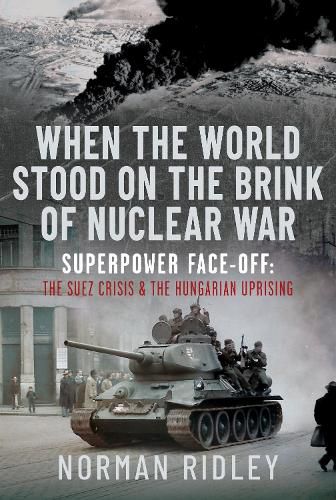Readings Newsletter
Become a Readings Member to make your shopping experience even easier.
Sign in or sign up for free!
You’re not far away from qualifying for FREE standard shipping within Australia
You’ve qualified for FREE standard shipping within Australia
The cart is loading…






The post-war world was dominated by the U.S.A. and the U.S.S.R., but the events of 1956 exposed their limitations. On 22 October 1956, following Egyptian leader Gamal Abdel Nasser's nationalisation of the Suez Canal, British Prime Minister Anthony Eden secretly met with French and Israeli leaders in Sevres, France. They agreed that Israel would invade Egypt, with Britain and France intervening under the guise of peacemaking to secure control of the canal and topple Nasser. On 23 October, far from the Middle East, hundreds of thousands of protesters in Budapest opposed Soviet occupation, tearing down Stalin statues. The uprising escalated as the Soviet Red Army intervened, leading to twelve days of violence, thousands killed or injured, and 250,000 Hungarians fleeing their country. Britain and France withdrew from the Suez after nine days of fighting, their ambitions thwarted by international pressure and canal closure. The U.S. and U.S.S.R. struggled to influence these events. The U.S., preoccupied with domestic elections and the threat of Soviet nuclear retaliation, could not support Eastern European movements. Soviet actions during the Hungarian uprising weakened their global image. Norman Ridley's analysis reveals how these crises highlighted the limitations of superpower influence. Despite their nuclear strength, the U.S.A. and U.S.S.R. faced challenges they could not overcome, showing their mutual struggles in shaping the post-war world order. AUTHOR: Norman Ridley is an Open University Honours Graduate who writes about the less well covered aspects of 20th Century history. He lives in the Channel Islands. 16 b/w illustrations
$9.00 standard shipping within Australia
FREE standard shipping within Australia for orders over $100.00
Express & International shipping calculated at checkout
The post-war world was dominated by the U.S.A. and the U.S.S.R., but the events of 1956 exposed their limitations. On 22 October 1956, following Egyptian leader Gamal Abdel Nasser's nationalisation of the Suez Canal, British Prime Minister Anthony Eden secretly met with French and Israeli leaders in Sevres, France. They agreed that Israel would invade Egypt, with Britain and France intervening under the guise of peacemaking to secure control of the canal and topple Nasser. On 23 October, far from the Middle East, hundreds of thousands of protesters in Budapest opposed Soviet occupation, tearing down Stalin statues. The uprising escalated as the Soviet Red Army intervened, leading to twelve days of violence, thousands killed or injured, and 250,000 Hungarians fleeing their country. Britain and France withdrew from the Suez after nine days of fighting, their ambitions thwarted by international pressure and canal closure. The U.S. and U.S.S.R. struggled to influence these events. The U.S., preoccupied with domestic elections and the threat of Soviet nuclear retaliation, could not support Eastern European movements. Soviet actions during the Hungarian uprising weakened their global image. Norman Ridley's analysis reveals how these crises highlighted the limitations of superpower influence. Despite their nuclear strength, the U.S.A. and U.S.S.R. faced challenges they could not overcome, showing their mutual struggles in shaping the post-war world order. AUTHOR: Norman Ridley is an Open University Honours Graduate who writes about the less well covered aspects of 20th Century history. He lives in the Channel Islands. 16 b/w illustrations